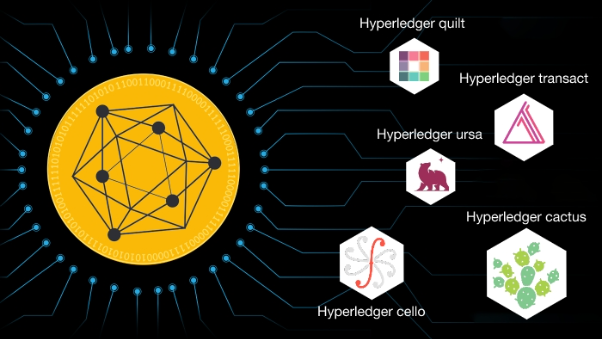Hyperledger is an open-source project aiming to facilitate blockchain-based distributed ledger technology development. It was created in 2016 by the Linux Foundation and has received contributions from various organizations, including IBM, Intel, Samsung, Microsoft, Visa, American Express, and various blockchain startups.
The project focuses on creating frameworks, standards, tools, and libraries for building blockchains and related applications, and it serves as a hub for various distributed ledger technologies. Businesses can use Hyperledger’s frameworks and tools to improve their processes’ efficiency, performance, and transactions.
This article offers a comprehensive analysis of all Hyperledger development tools and frameworks.
Hyperledger Framework
Here is a list of frameworks for creating blockchain applications based on distributed ledgers
Hyperledger Fabric
Hyperledger Fabric is a permissioned blockchain primarily developed as an integration framework for developing highly scalable blockchain applications with distributed ledger technology. The framework comprises a modular architecture that divides the role between the nodes within the infrastructure and includes configurable consensus and membership services. Fabric is designed to support the execution of smart contracts called chaincode using container technology. The technology helps the contracts to contain the application logic of the system.
Some of its salient features are:
- Private channels to share confidential information
- Membership and ordering services
- CouchDB for storing world state
Hyperledger Indy
Hyperledger Indy is a distributed ledger having a prime focus on decentralization. It facilitates a robust and secure ecosystem for creating private digital identities on a blockchain network. Indy provides a range of libraries, reusable components and tools for creating digital identities. Using blockchain technology to eliminate third-party interference, the framework provides more power to its users. The private data of each user is publicly visible and is completely under the control of the respective user. This encourages transparency and safeguards their information from malicious attacks and data breaches.
Some of its salient features are:
- Globally unique and resolvable decentralized identifiers
- Zero-knowledge proofs prove the authenticity of any data without revealing any additional information.
- Digital identities provided by Indy are interoperable, transparent, portable and highly protected.
Hyperledger Sawtooth
Hyperledger sawtooth is an enterprise-level, permissioned, blockchain-as-a-service platform mostly used for deploying, running, and building blockchain networks and applications. In collaboration with IBM, Intel, and SAP, Linux Foundation developed Sawtooth to make ledgers truly distributed and smart contracts much more secure. The platform simplifies application development by segregating the core ledger system from the application-specific environment. This further helps build applications using the programming language of one choice without interfering with the core blockchain system. Hyperledger sawtooth supports various consensus algorithms, including PBFT and P0ET and languages such as C, C++, Go, JavaScript, Python, and Rust.
Some of its salient features are:
- Parallel transaction execution
- Dynamic consensus
- Transaction families
Hyperledger Iroha
Hyperledger Iroha is a blockchain framework hosted by Linux for incorporating distributed ledger technology into infrastructural projects. It was initially contributed by Soramitsu, Hitachi, NTT Data, and Colu. Iroha is widely used for building mobile applications that suit business needs and identity management systems such as national IDs. It features a domain-driven programming language (C++) and a consensus algorithm called YAC (Yet Another Consensus algorithm). This algorithm helps execute a sequence of instructions through a step-by-step process written in code.
Some of its salient features are:
- Compatible with operating systems like Linx, Windows, and macOS.
- The modular and plug-in design of Iroha helps in easy adoption.
- Multi-signature functionalities for transactions.
Hyperledgers tools
Hyperledger frameworks support the following tools for building Blockchain applications:
Hyperledger Caliper
Blockchain performance is a major concern for users, but there is currently no widely accepted tool for evaluating the performance of different blockchain solutions based on neutral, commonly accepted criteria. While there are reports on the performance of various blockchain implementations in different scenarios, there is no standardized benchmarking tool for comparing these implementations.
Hyperledger Caliper is a blockchain framework benchmarking tool that relies on an existing blockchain implementation as the target for evaluation. It produces reports with performance indicators such as TPS (Transactions Per Second), transaction latency, and resource utilization. The goal of Caliper is to provide a reference for other Hyperledger projects as they build out their frameworks and to help users choose a blockchain implementation that meets their specific needs.
Hyperledger Cello
Hyperledger Cello is a blockchain implementation and operation system that operators can use to connect blockchain networks to existing business infrastructure. It functions as a Blockchain-as-a-Service (BaaS) platform, allowing enterprises to customize their blockchain networks according to their preferred size and consensus type. This gives enterprises the flexibility and freedom to explore the potential of different blockchain solutions without investing heavily in implementation efforts.
For developers, Hyperledger Cello can be used to create BaaS platforms, implement customizable blockchain solutions, monitor system health, perform various operations and tests, and run and maintain multiple blockchain networks on top of existing infrastructure.
Hyperledger Besu
Hyperledger Besu is an open-source Ethereum client written in Java and developed under the Apache 2.0 license. It is the first Blockchain project on Hyperledger that supports operations across public Blockchains. Besu is designed to be an ideal platform for open-source development and deployment. It leverages the Ethereum public network for operations and is specifically tailored for enterprises, providing a reliable platform for building the public network.
The architecture and design of Hyperledger Besu focus on modularity and clean interfaces, which allows for easier implementation and upgrades of all components. It is also flexible enough to integrate different Hyperledger projects and specific use elements in the codebase. Hyperledger Besu can run on Ethereum’s public network and networks with private permissioning and test networks like Gorli, Rinkeby, and Ropsten.
Hyperledger Explorer
Hyperledger Explorer is a Blockchain Web UI that provides visual representations of blockchain operation metrics and helps users manage and maintain blockchains and distributed ledgers without needing technical expertise. It uses technologies such as ReactJS, Material-UI from Google, and web sockets and currently supports Hyperledger Fabric and Hyperledger Iroha (alpha release).
In Hyperledger Fabric, Hyperledger Explorer can retrieve admin credentials through Credential Authority (CA), manage additional users, support Modular Transport Layer Security connection and enable HTTPS. Additionally, it allows viewing transactions on the network and monitoring the latest status of blocks, networks, and chaincodes.
Hyperledger Quilt
Hyperledger Quilt offers interoperability among ledgers by implementing the Interledger Protocol (ILP) in Java. The quilt acts as a bridge between distributed ledgers, private ledgers, wallets, and supply chain systems to enable distributed atomic transactions.
Currently, it only allows for payments (fiat and cryptocurrency) across payment networks, but it has the potential to transfer any digital asset with further development. The Quilt library offers ledger interoperability with common escrow semantics, a new standard for ledger-agnostic address and data packet format for routing payments, and a framework for designing more use-case-specific protocols beyond payments.
Blockchain composer
Hyperledger Composer is a comprehensive open development toolset and framework designed to make it easy and fast to create smart contracts and blockchain applications. Built with JavaScript and using modern tools such as node.js, npm, CLI, and popular editors, Composer provides business-centric abstractions and sample apps with simple DevOps processes. This helps to create robust blockchain solutions that align with business requirements and technical development.
It supports the Hyperledger Fabric blockchain infrastructure and runtime, which uses pluggable blockchain consensus protocols to ensure that transactions are validated according to policy by the designated business network participants. Adopting Hyperledger Composer allows clients to create blockchain applications faster, reduce risk with well-tested and efficient design, and enjoy greater flexibility through the ability to iterate and connect to existing applications via APIs.
Conclusion
In conclusion, Hyperledger is a valuable resource for businesses and developers looking to leverage the power of blockchain technology and distributed ledger technology. Hyperledger’s unique frameworks and tools demonstrate its significant potential for emerging technologies like blockchain. These tools can create highly scalable and reliable industrial and non-monetary applications.













